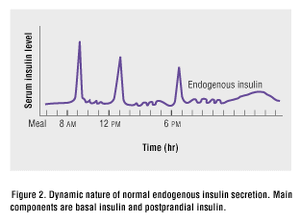
In this graph of insulin secretion of a non-diabetic, the basal insulin levels are shown as the lower, often wavy lines. The higher, sharp "spikes" are of more insulin secretion caused by eating a meal.

Illustration of how glucose rises after meals and how the normal working pancreas responds by secreting insulin above the basal (body's needs without food) level to manage the rise in glucose. Glucose levels are at top-insulin levels at bottom. The large rises seen in both are due to meals.
This refers to the body's basic need for insulin to keep itself in proper condition. A non-diabetic's pancreas secretes this basal or "basic" insulin in sufficient quantities at all times. Basal insulin secretion is a series of small pulses or spurts at a given rate day and night. Insulin-dependent diabetics don't and they need to inject an intermediate or long lasting insulin 1-3 times a day to replace what their bodies lack.
When someone without diabetes eats a meal, the pancreas goes into higher gear, turning out larger quantities of post-prandial insulin to handle the additional glucose created by the food. This phase of insulin secretion is often referred to as the first phase, while the steady, slow basal rate is termed the second phase. [1]
Dogs who don't have diabetes have a similar insulin secreting pattern to people who don't have diabetes, with the same two phases intended for the same purposes as in humans. [2][3]
Even if your pet is not eating, his or her body still requires some insulin; this need does not disappear because a dog or cat doesn't eat. [4]
Intervet [5] advises a basal dose of approximately 30% of normal insulin dose when a diabetic pet isn't eating. This should be discussed with your vet even if you do not need the information at present. Knowing what he or she considers to be your dog's basal insulin dose should be noted in case of need. [6]
Basal insulins are generally either the intermediate-acting or long-acting insulins. Most of us with diabetic pets are fortunate enough to have a basal insulin we give twice a day able to cover the pet's mealtimes as well. People are not so fortunate; they need to use a fast or rapid-acting bolus insulin to cover what they eat. Some pets, especially dogs, require this too.
Before there were insulin suspensions, there was no such thing as basal insulin. All of it was short-acting R/neutral type which made it necessary for those with diabetes to take many shots a day to maintain their blood glucose levels.
Some people with diabetes refer to their basal as their "background" insulin. Another term for this type of insulin [7] for this type of insulin is depot Insulin.
For other uses of rapid-acting or short-acting insulins in addition to a basal dose, see bolus and corrective insulin. ![]()
References[]
- ↑ Insulin Release. Wikipedia.
- ↑ Hess, Rebecka (May 2008). Managing Diabetes Mellitus in Dogs. DVM 360.
- ↑ Insulin is essential for many metabolic processes. ACVIM (1999).
- ↑ Your Insulin Therapy. American Family Physician (2004).
- ↑ Information on Basal Insulin Dose-page 15. Intervet.
- ↑ Insulin Injections for Dogs. BD Diabetes.
- ↑ Depot Insulin. Mendosa.com.